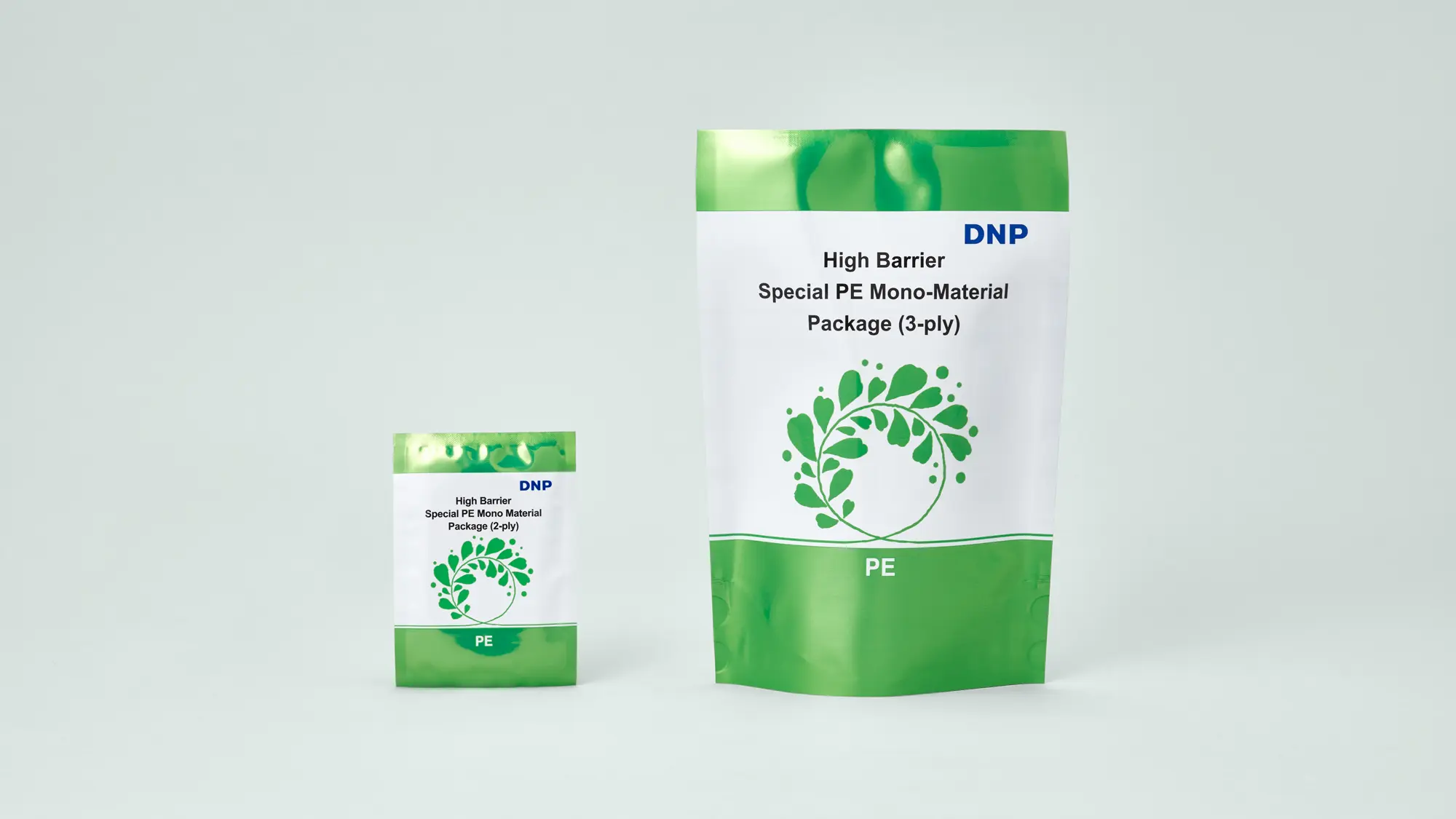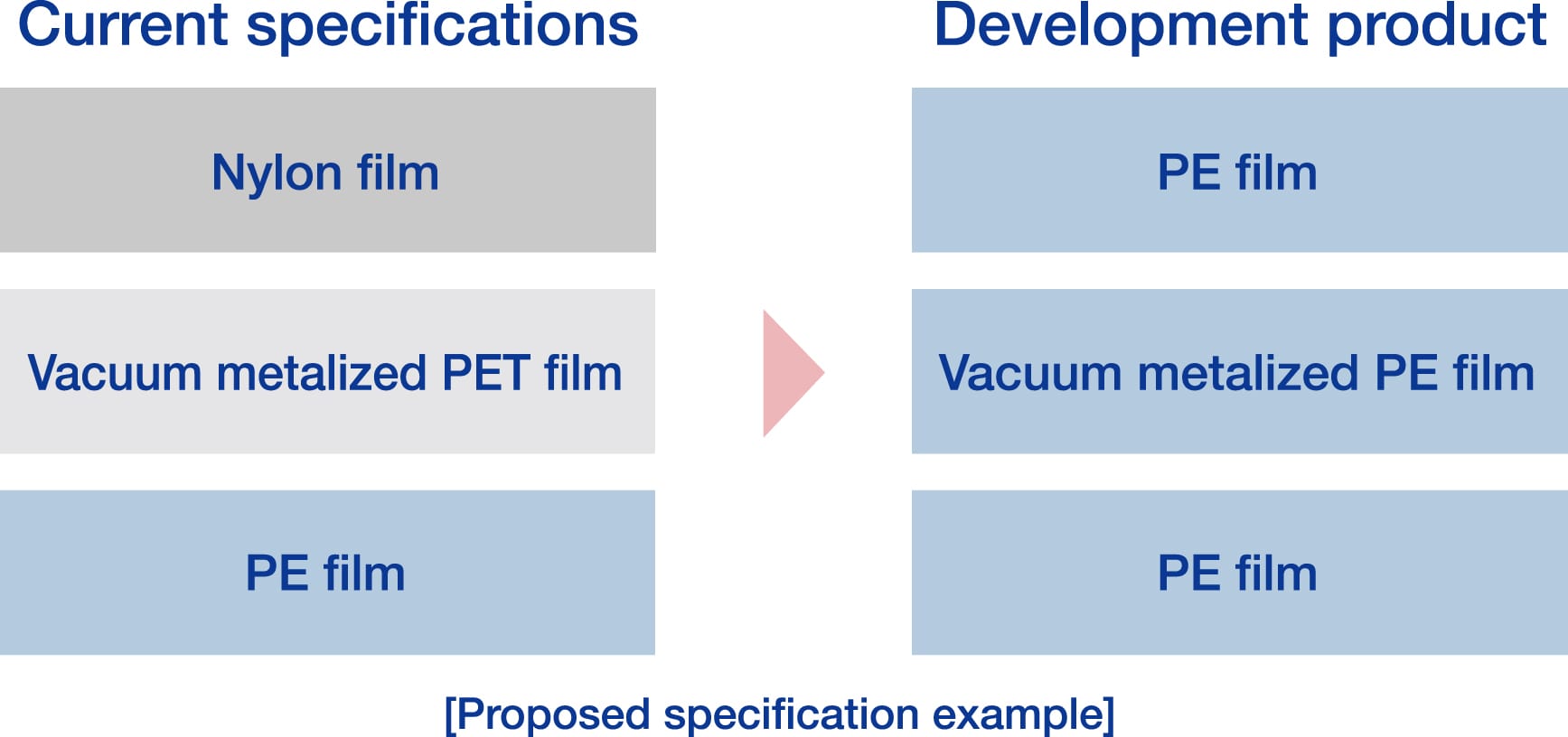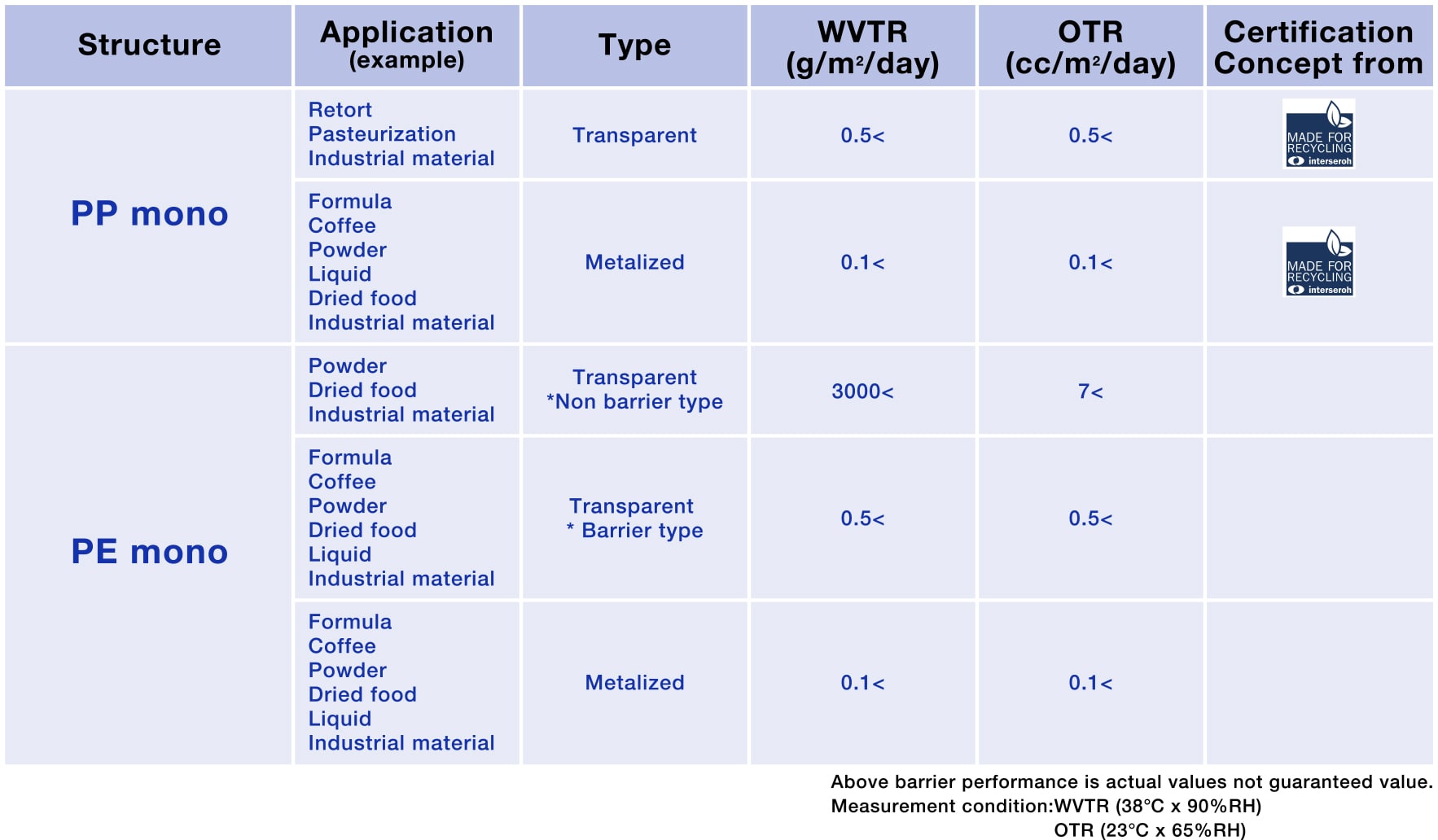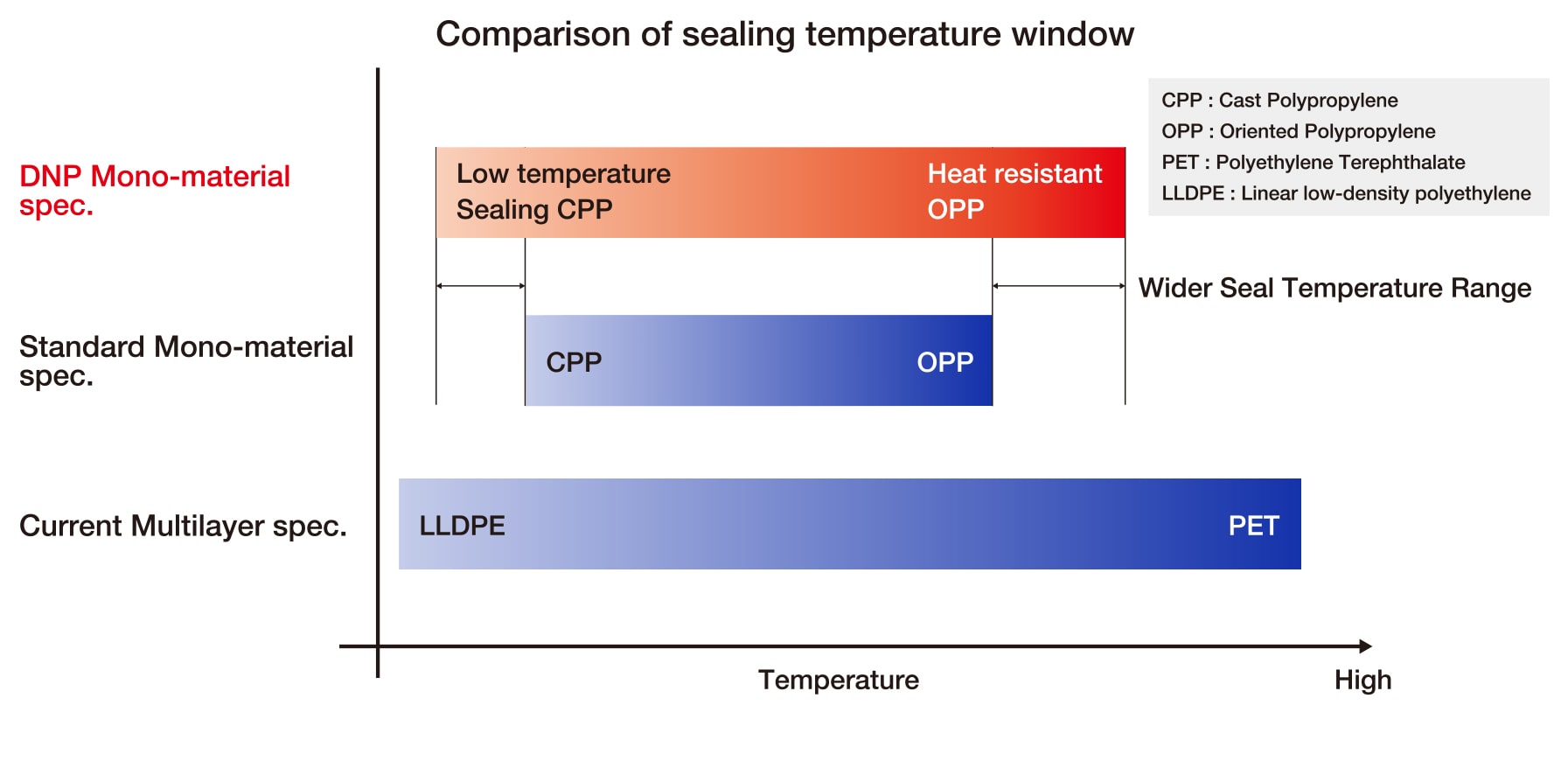Easy to recycle, single-material packaging
DNP's Mono-material Packaging
This environmentally friendly package is made from a single material (Mono-material), making it easy to recycle.
To tackle environmental problems such as ocean plastic waste pollution, the world is promoting plastics recycling to realize a recycling-oriented society, and Mono-material packaging is attracting attention in this context.
DNP has been pioneering Mono-material packaging with polyethylene (PE) and polypropylene (PP) specifications by adding the necessary functions to the packaging using our proprietary converting, film-forming, and vapor deposition technologies cultivated to date.

See 11 related fields
See related articles
Table of contents
- What is Mono-material?
- Why is Mono-materialization necessary?
- Product lineup
- Applications
- DNP implementation track record
- DNP's strengths
- DNP's support system
- Mono-material FAQ collection
- Related articles on the site
What is Mono-material?
Flexible packaging is widely made of multiple materials with different advantages which are laminated together to provide packaging functions such as shelf life and strength. For example, PET is used for heat resistance, aluminum foil or aluminum vapor-deposited film is used to protect the contents from oxygen and water vapor, and nylon is used to increase impact resistance. However, the challenge is hard to separate multiple materials and it's recycability .
One solution to this problem is Mono-material packaging, which is made from a single material but has functional properties such as shelf life and strength. Since it comprises a single material, it is easier to be recycled in the recycling process and improves the quality of the recycled material. Mono-material packaging is attracting particular attention in countries and regions where plastic recycling is being promoted to realize a recycling-oriented society.
|
|
Why is Mono-materialization necessary?
Mono-materials for a recycling-oriented society
Currently, material recycling, chemical recycling, and thermal recovery are the three main methods of effective utilization of waste plastics in the world. In Japan, where incineration technologies and facilities are widely used, thermal recovery accounts for a large proportion of plastic waste management. On the other hand, incineration technologies and facilities are not so common overseas in comparison to Japan, and material recycling and chemical recycling are even more widespread.
|
|
By laminating films with various characteristics, a highly functional packaging can be created for each application.
Performance may be inferior to that of multi materials. The key point of development is to provide the same functionality with a single material as before.
Multi materials are difficult to separate and impose a heavy load when recycled.
It is said that Mono-material is easier to recycle in the recycling process. Quality as recycled material can be easily improved.
Material recycling is excellent in terms of environmental impact and is an important way to use waste plastics, but one obstacle is that the quality of recycled materials is affected by contamination with different materials.
Mono-materials are indispensable as a technology that improves the quality of recycled materials and contributes to a recycling-oriented society, and an increasing number of countries and companies are working on Mono-material.
Plastic Recycle in EU
In Europe, the advocacy of the circular economy has triggered calls for plastics recycling. The circular economy is a concept of a new economic system in which waste generated by economic activities are recycled and made recyclable. Since the EU announced it as one of its policies in December 2015, it has become a common feature in various activities.
Product lineup
PE Mono-material packaging with aluminum deposition
|
|
Key features:
● This package is designed for easy recycling by using polyethylene (PE) as a Mono-material, with over 90% of the packaging being made from PE.
● The design conforms to the guidelines of CEFLEX (a circular economy for flexible packaging), a initiative promoting a circular economy in the European flexible packaging industry.
● Utilizing proprietary converting technology, it incorporates aluminum-deposited PE, providing a metallic appearance without using aluminum-deposited PET or aluminum foil. It is particularly suitable for applications where design is crucial, such as daily-use items.
|
|
PE Mono-material packaging
|
|
Key features:
● This packaging is designed for easy recycling by using polyethylene (PE) as a Mono-material, with over 90% of the package being made from PE.
● The design conforms to the guidelines of CEFLEX (a circular economy for flexible packaging), a consortium promoting a circular economy in the European flexible packaging industry.
● Thanks to proprietary converting technology, it can be used as a transparent substrate for printing, allowing a transition from packages using different materials such as PET and nylon.
|
|
PP Mono-material packaging with aluminum deposition
|
|
Key features:
● This environmentally conscious packaging is designed for easy recycling by using polypropylene (PP) as a single material, with over 90% of the packaging being made from PP.
● The design is compliant with the guidelines of CEFLEX (a circular economy for flexible packaging), a consortium promoting a circular economy in the European flexible packaging industry.
● Using a newly developed PP-based transparent deposition film, it achieves oxygen transmission rate and water vapor transmission rate of 1 ml/m2·day·atm and 1 g/m2·day or less after pasteurization , and 2 ml/m2·day·atm and 2 g/m2·day or less after retort sterilization.
● It is intended for use in pouches and plastic container lids that undergo pasteurization or retort sterilization, where the use of a single material was traditionally challenging.
|
|
PP Mono-material packaging for boiling sterilization
|
|
Key features:
● This environmentally conscious packaging is designed for easy recycling by using polypropylene (PP) as a single material, with over 90% of the packaging being made from PP.
● The design is compliant with the guidelines of CEFLEX (a circular economy for flexible packaging), a consortium promoting a circular economy in the European flexible packaging industry.
● Using a newly developed PP-based transparent deposition film, it achieves oxygen transmission rate and water vapor transmission rate of 1 ml/m2·day·atm and 1 g/m2·day or less after pasteurization , and 2 ml/m2·day·atm and 2 g/m2·day or less after retort sterilization.
● It is intended for use in pouches and plastic container lids that undergo pasteurization or retort sterilization, where the use of a single material was traditionally challenging.
|
|
|
|
Product specifications
DNP Barrier Mono-material package can retain high level of oxygen and water vapor barrier properties without using aluminum foil, metalized PET film or PET-based transparent vapor deposition film.
|
|
Applications
Food
OL_01.png)
|
|---|
- Dried material (Example: Pet food)
● Anticipated needs:
Oxygen and water vapor permeating from the outside can deteriorate the contents. For instance, dry pet food (drying material), known for its high oil content, is susceptible to the influence of oxygen and water vapor. Therefore, protection of the contents is essential.
Beverages
OL-02.png)
|
|---|
- Baby food
● Anticipated needs:
Oxygen and water vapor permeation from the outside can lead to the deterioration of contents. For example, baby food needs to provide a safe beverage and food option for infants, necessitating the protection of the contents.
Industrial materials such as electronic components and industrial products
OL-05.png)
|
|---|
- Industrial material
● Anticipated needs:
Some intermediate materials used in electronic devices and industrial products can be susceptible to damage from oxygen and water vapor. Depending on the extent of this impact, electronic devices may malfunction, leading to potentially significant accidents. Therefore, protecting the contents becomes especially crucial.
Retort products
OL-0304.webp)
|
|---|
● Anticipated needs:
Retort products are known for their long-term shelf-life features. For example, in wet pet food, owners may store the contents for an extended period, creating a need for providing food with peace of mind.
Personal care and household items such as shampoo and conditioner
OL-06.png)
|
|---|
● Anticipated needs:
When storing shampoo and conditioner, vapor barrier properties are sought to minimize the decrease in content weight due to fragrance and moisture evaporation.
Specification design
DNP's Mono-material packaging offers a lineup that caters to various applications. While there are multiple application examples, the key points for Mono-material packaging design include:
-Equivalent protection of contents against oxygen and water vapor as traditional specifications.
-Easy recyclability, contributing to the improvement of recycled material quality.
DNP provides a range of Mono-material packaging options, such as high-barrier polyethylene or polypropylene specifications, tailored to the contents.
DNP implementation track record
Cosmetic and healthcare products
7.webp)
|
|---|
Client: Colgate-Palmolive Company
Product: small sachets for shampoo and conditioner.
Reasons for adoption:
● Achieved equivalent barrier performance (against oxygen and water vapor) to existing packaging without using aluminum foil.
● Realized a metallic appearance comparable to film packaging using vacuum metalized PET, but without the use of aluminum foil.
Food and beverage
8_1.webp)
|
|---|
Client: LIPTON teas and infusions
Product: Lipton “Lipton Botanic Tea”, “Lipton Keep & Charge” exterior packaging.
Reasons for adoption:
● Achieved equivalent barrier performance (against oxygen and water vapor) and high-speed filling capabilities to existing packaging without using aluminum foil.
● Compared to existing specifications, an estimated 21.7 tons (DNP estimate) of CO2 reduction is expected when utilizing one million pouches.
DNP strengths
1. Global supply network
DNP has packaging manufacturing bases in Japan, Indonesia, and Vietnam. We can respond to customers who are expanding globally.
2. System design support
DNP not only provides Mono-material packaging materials but also provides filling system support to ensure that packagings can be successfully mounted on filling machines.
3. Key technology
DNP supports customers' Mono-materialization with its unique technologies, such as the selection of appropriate materials in consideration of physical properties and productivity, in addition to its delivery experience in food, daily necessities, medical, and other fields.
4. Compliance with global standards
DNP provides Mono-material packaging materials that meet the standards for plastic recycling in Europe and the United States. DNP is a member of CEFLEX, a consortium that promotes a circular economy in the European flexible packaging industry and is designing and proposing specifications that comply with the latest guidelines.
|
|
5. Calculating objective effects through quantification
In some cases, stakeholders require a quantitative explanation of the reduction in environmental impact resulting from the switch to Mono-materials, and DNP is working to visualize the environmental impact of packaging throughout its lifecycle, from raw material procurement to manufacturing and disposal.
6. Wide range of seal temperature adjustment
DNP's Mono-material packaging excel in their wide range of adjustable sealing temperatures. This allows customers to enjoy more flexible manufacturing conditions when sealing packages, reducing the complexity of temperature control. Conventional OPP substrates have limited heat resistance, and CPP lacks low-temperature sealing properties, but DNP's technology solves these problems. By enabling sealing over a wide temperature range, users can operate with more leeway during the manufacturing process and quality control becomes easier. In this way, DNP offers packaging solutions that ensure efficiency and consistent quality.
|
|
How DNP supports
In order to realize Mono-materialization, it is necessary to consider such matters as (1) contents, (2) optimal filling conditions, (3) Shelf-life tests, (4) setting of proper shelf life, and (5) transportation conditions.
DNP has a support system in place to help you consider these issues through the following development flow and will work with you to realize Mono-materialization.
|
|
Mono-material FAQ collection
- Can Mono-material structure be used for frozen foods?
- Yes. It can be used for frozen foods as well.
Generally, even if food is frozen, oxidation progresses when it comes into contact with air. This condition is known as “freezer burn”, which not only causes discoloration and an unappealing appearance but also compromises the flavor and texture. Therefore, packaging materials for frozen foods often utilize materials with high oxygen barrier properties, such as nylon, or materials with excellent cold resistance and water resistance, such as PET. DNP can achieve a level of quality retention performance similar to existing products while enabling a transition to Mono-material. - Are there any points to consider when adopting it?
- Mono-material films are created by combining materials with different characteristics, such as aluminum foil or PET, into films with similar characteristics in PP, PE. However, please understand that equivalent performance may not be achieved. Additionally, proper evaluation is essential as differences in performance may arise.
- Can you tell us about the initiatives regarding materials in Japan as a whole?
- In Japan, the “Act on Promotion of Resource Circulation for Plastics” (Plastic Resource Circulation Act) came into effect in April 2022. This law sets forth guidelines for the design of products using plastics, specifying matters that manufacturing businesses should address and consider. Mono-materialization is included in these guidelines.
- Where is DNP's Mono-material packaging material manufactured?
- The packaging manufacturing facilities are located in Japan, Indonesia, and Vietnam. We will consider the optimal manufacturing facility according to your requirements, so we will conduct a preliminary interview.
- Are there any constraints on the contents?
- We have designed materials and specifications suitable for a wide range of contents, but it is necessary to thoroughly understand your requirements in advance. Various verifications such as filling tests and storage evaluations are required.
Related articles on the site
An Interview with DNP Indonesia, the Frontline of Development and Sales Promotions
See 11 related fields
See related articles

en-min_1.jpg)













